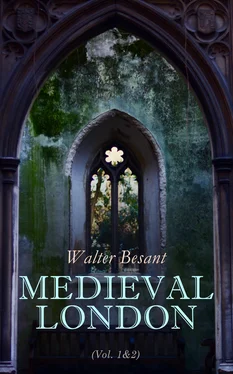In 1429 the King, being then eight years of age, was crowned at Westminster before being taken over to France to be crowned there. The ceremony and order of the coronation service are fully set forth by Gregory:—
“Nowe of the solempnyte of the coronacyon. Alle the prelatys wente on processyon beryng eche of hem a certayne relyke: and the Pryor of Westemyster bare a rodde callyde Virga regia , ande the Abbot of Westemyster bare the kyngys ceptoure. And my Lorde of Warwyke bare the kynge to chyrche in a clothe of scharlet furryd, evyn as the newe knyghtys of the Bathe wente whythe furryde hoodys with menyver. And then he was led up in to the hyghe schaffold, whyche schaffold was coveryd alle with saye by twyne the hyghe auter and the quere. And there the kyng was sette in hys sete in the myddys of the schaffold there, beholdynge the pepylle alle aboute saddely and wysely. Thenne the Arche-byschoppe of Cantyrbury made a proclamacyon at the iiij quartyrs of schaffolde, sayynge in thys wyse: ‘Syrys, here comythe Harry, Kyng Harry the v ys sone, humylyche to God and Hooly Chyrche, askynge the crowne of thy(s) realme by ryght and dyscent of herytage. Yf ye holde you welle plesyd with alle and wylle be plesyd with hym, say you nowe, ye! and holde uppe youre hondys.’ And thenne alle the pepylle cryde with oo voyce, ‘Ye! ye!’ Thenne the kynge went unto the hyghe auter, and humely layde hym downe prostrate, hys hedde to the auter warde, longe tyme lyyng stylle. Thenne the arche-byschoppys and byschoppys stode rounde a-boute hym, and radde exercysyons ovyr hym, and many antemys i-song by note. And thenne the arche-byschoppes wente to hym and strypte hym owte of hys clothys in to hys schyrte. And there was yn hys schyrte a thynge lyke grene taffata, whyche was i-lasyd at iiij placys of hym. Thenne was he layde a downe a yenne, and helyd hym with hys owne clothys yn the same maner a-fore sayde. And thenne the Byschoppe of Chester and of Rouchester songe a letany ovyr hym. And the Arche-byschoppe of Cantyrbury radde demany colettys ovyr him. Thenne the arche-byschoppys toke hym uppe a gayne and unlasyd hym, and a-noynted hym. Fyrste hys bryste and hys ij tetys, and the myddys of hys backe, and hys hedde, alle a-crosse hys ij schylderys, hys ij elbowys, his pamys of hys hondys: and thenne they layde a certayne softe thynge as cotton to alle the placys a-noyntyd: and on hys hedde they putt on a whyte coyffe of sylke. And so he wentte viij days: and at the viij dayes the byschoppys dyde wasche hit a-waye with whyte wyne i-warmyd leuke warme. And the knyghtys of the Garter helde a clothe of a-state ovyr hym alle the whyle of his waschynge. To the fyrste processe, aftyr the oyntynge he layde hym doune prostrate a-gayne. Thenne the arche-byschoppys raddyn solempne colettys with a solempne prefas. And thenne they toke hym up a-gayne and putte a-pon hym a goune of scharlette whythe a pane of ermyn, and Synt Edwarde ys sporys, and toke hym hys cepter in hys honde, and the kyngys yerde i-callyd Virga regia in hys othyr honde, sayyng there-with, Reges eos in virga ferrea , etc., he syttyng thenne in a chayre by fore the hyghe auter. And thenne alle the byschoppys seseden with a swerde, they alle syttynge there hondys thereon, ande alle they saynge thes wordys thys to hym, Accingere gladio tuo super femur tuum, potentissime . And at every tyme the kyng answeryd and sayde, Observabo . Thenne toke they the swerde a-gayne fro hym, and layde the swerde on the hyghe auter. Thenne bought the kyng hys swerde a-gayne of Hooly Chyrche for an C s. in signe and in tokyn that the vertu and power sholde come fyrste fro Hooly Chyrche. Thenne sette they on hys hedde Synt Edwarde ys crowne. Thenne rose he owte of hys chayre and layde hym downe prostrate a-gayne. And there the byschoppys sayde ovyr hym many hooly colettys. And thenne they toke hym up and dyspoylyd hym of hys gere a-yen, and thenne a-rayde hym as a byschoppe that sholde sing a masse, with a dalmadyke lyke unto a tunycule with a stole a-bowte hys necke, not crossyd, and a-pon hys fete a payre of sandellys as a byschoppe, and a cope and glovys lyke a byschoppe: and thenne sette a-yen on hys hedde Synt Edward ys crowne, and layde hym a-pon the schaffold and sette hym a sete of hys astate, and ij byschoppys stondyng on every syde of hym, helpyng hym to bere the crowne, for hyt was ovyr hevy for hym, for he was of a tendyr age. And then they be-ganne the masse, and the Arche-byschoppe of Cauntyrbury songe the masse. And a nothyr byschop radde the pystylle. And the Byschoppe of Worsethyr radde the gospelle at the auter. And at the offretory come the kyng downe and made the oblacyon of brede and wyne, there whythe offerynge a pounde weyght of golde, the whiche contaynyd xvj marke of nobbelys. And thenne wente he uppe a-gayne in to the schaffold and satte there in hys sete tylle the iij Agnus Dei, and thenne he come downe a-gayne and layde hym prostrate saying there hys Confyteor and alle the prelatys sayde Misereator . And thenne he sate uppe, knelynge with humylyte and grete devocyon, ressavyng the iij parte of the holy sacrament apon the paten of the chalys of the Arch-byschoppe handys. Thenne there come the Byschoppe of London with the grete solempne chalys by Synt Edwarde and servyd hym whythe wyne: the whyche chalis by Synt Edwarde ys dayes was praysyd at xxx M marke: and the Cardenalle of Wynchester and a othyr byschoppe helde to hym the towelle of sylke: and so he knelyd stylle tylle mas was i-doo. Thenne rosse he up a-gayne and yede a-fore the schryne, and there was he dyspoylyde of all the ornamentys that he weryde, lyke the ornamentys of a byschoppe, as hyt was sayde by-fore: and thenne he was a-rayde lyke a kynge in a ryche clothe of golde, with a crowne sette on hys hedde, whyche crowne Kynge Rycharde hadde made for hym selfe. And so the kynge was ladde thoroughe the palys yn to the halle, and alle the newe knyghtys be-fore hym in hyr a-raye of scharlette: and thenne all the othyr lordys comynge aftyr hym: thenne come the othyr lordys comynge aftyr hem. Thenne come the chaunceler with hys crosse bare heddyd: and aftyr hym come cardenelle with hys crosse in hys abyte lyke a chanon yn a garment of rede chamelett, furryd whythe whyte menyver. And thenne folowyde the Kynge, and he was ladde by-twyne the Byschoppe of Dyrham and the Byschoppe of Bathe; and my goode Lorde of Warwyke bare uppe hys trayne. And byfore hym rode my Lorde of Saulysbury as Constabylle of Ingelonde in my Lorde of Bedforde hys stede, and thenne my Lorde of Glouceter as Stywarde of Ingelonde. And aftyr hym rode the Duke of Northefolke as Marchalle of Ingelonde. And before the kynge iiij lordys bare iiij swerdys, ij in there schaberdys and ij nakyde. And one wa[s] poynteles of the iiij swerdys above sayde. And as they [were] syttyng at mete the kyng kepte hys astate: and on the ryght honde sate the Cardynalle whythe a lower astate: and on the lyfte syde sate the chaunceler and a byschoppe of Fraunce, and noo moo at that tabylle. And on the ryght honde of the halle at that borde kepte the baronys of the Fyffe portys, and soo forthe, clerkes of the Chaunsery: and on the lefte honde sate the Mayre of London and hys aldyrmen, and othyr worthy comynerys of the cytte of London. And in the myddys of the halle sate the byschoppys, and justysys, and worthy knyghtys, and squyers, and soo fyllyde bothe the myddylle tabyllys of the halle. And at the ryght honde of the halle uppon a schaffolde, stode the kyngys of harowdys alle the mete tyme in hyr cote armorys and hyr crownys in hyr heddys. Ande at the fyrste course they come downe and wente by fore the kyngys champyon, Syr Phylyppe Dymmoke, that rode in the halle i-armyde clene as Syn Jorge. And he proclaymyd in the iiij quarterys of the halle that the kynge was ryghtefulle ayre to the crowne of Ingelonde, and what maner man that wolde nay hyt, he was redy for to defende hyt as hys knyghte and hys champyon. Ande by that offyce he holdythe hys londys, etc.” (“Chronicle” in Collection of a London Citizen.) William Gregory as a good citizen cannot refrain from giving the menu of the Coronation banquet. One pities the poor child having to go through the long ceremony of the Abbey first and having to sit out this long banquet afterwards.
Читать дальше












